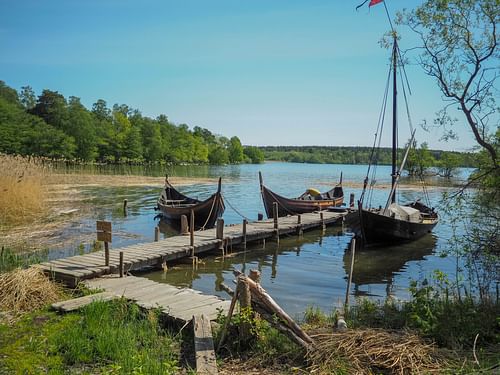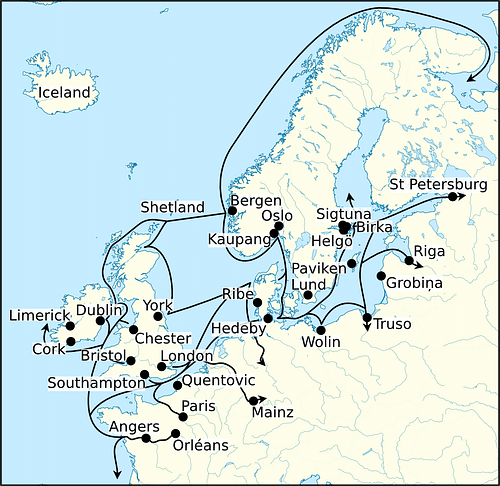
Birka, located on the island of Björkö in present-day Sweden, was an important trading center and strongly fortified town in the Viking Age which flourished from the 8th through the 10th centuries CE. Along with the town of Hedeby which is located in present-day Denmark, Birka was the most important Viking trading center in Europe. Due to its prime location on Lake Mälaren, which provided sailing access to the Baltic Sea through the Södertälje Canal, Birka attained great wealth as a mercantile settlement and entrepôt with extensive trading ties to Western Europe, Scandinavia, the Slavic and Byzantine east, as well as the Arab World. Birka was also the location where the Frankish missionary St. Ansgar (801-865 CE) first introduced the Swedes to Christianity c. 829-831 CE. UNESCO recognized Birka's importance in early medieval European history, declaring its archaeological site a World Heritage Site in 1993 CE, together with the neighboring site of Hovgården on the island of Adelsö.
Geography & Early History
Birka is located on the Swedish island of Björkö, which sits about 35 km (22 miles) to the southwest of the Viking town Sigtuna and 30 km (19 miles) west of Stockholm. In the Viking Age (c. 790-1100 CE), Lake Mälaren functioned as a bay adjacent to the Baltic Sea, and Birka was thus perfectly positioned near the northern long-distance trade routes that ran between the British Isles, Western Europe, the Kievan Rus, the Byzantine Empire, and the Abbasid Caliphate.
Although Danish and Norwegian Vikings sailed westwards towards the British Isles, Iceland, and Western Europe from the 8th-11th centuries CE, Swedish Vikings sailed eastwards, trading and raiding their neighbors in what is present-day Finland and Estonia as well as the Slavic Wends who inhabited what is now present-day eastern Germany. By the 800s CE, Swedish Vikings had managed to navigate their ships through the rivers of what is now Russia and Ukraine, penetrating as far as the Byzantine Empire and Abbasid Caliphate via the Dnieper, Don, and Volga Rivers. They brought back furs, silks, iron artifacts, and other luxury goods to Birka, which they then sold to merchants from Hedeby and Western Europe. The wealth that traversed the Baltic Sea also helped encourage Birka's founding at some point between c. 750-800 CE. As one of the earliest Viking trading hubs and one which generated (and, in turn, spread) tremendous wealth, Birka can be viewed as a catalyst for social and economic development in Scandinavia and Eastern Europe, becoming part of a larger network of trading centers which sprung up across the region.
There had been an earlier trading center on the island of Helgö, which is located about 8 km (5 miles) to Birka's southeast, and it is probable that both Helgö and the area in and around Birka became inhabited sometime around c. 400 CE. The name “Birka” might mean "marketplace" or "place of commerce", although its location on the island of Björkö ("birch island") fosters the idea of a connection with the Old Norse word bjǫrk, meaning "birch tree". It is likely that the Swedish kings who ruled from the nearby island of Adelsö – this is where the royal residence of Hovgården was located – oversaw or took some part in Birka's founding and the organization of economic activities on the island of Björkö. Birka, located in proximity to the royal court, was protected by royal charters as the town greatly enriched royal and noble coffers.

Daily Life in Birka
Birka was Sweden's largest town for two centuries, and archaeologists believe that Birka covered an area of about 7 hectares (17 acres), had three harbors, and contained a population of between 600-1000 people. Birka needed strong defences as the town was the site of frequent attacks by pirates who could hide out on Lake Mälaren's various islands for weeks at a time without being detected; St. Ansgar, who was the first to preach the Christian gospel to the Swedes at Birka was a victim of these pirates around c. 829 CE. A series of fortified structures, including a rampart, a small hillfort, and stakes that prevented unauthorized entrance into Birka's main harbor, protected the settlement from prolonged and surprise attacks. Of special note is Birka's 1.8 m (6 ft) tall earth- and stone rampart with a palisade and towers at every entrance point.
Because archaeologists have unearthed so many weapons at gravesites in Birka, it is believed that a garrison of soldiers was stationed within the town. Birka was the residence of local craftsmen and artisans like blacksmiths, carpenters, weavers, comb-makers, shipbuilders, and potters who operated their own shops and workshops. Houses in Birka were built in rows posited towards the docks, and passageways were flanked in turn by ditches. Most buildings were timber-framed and had roofs made from wood, thatch, or even turf. Walls were made from wattle-and-daub. Archaeologists and historians surmise that Birka had summer and winter markets; it is entirely possible that fur traders from Scandinavia used skates and sleds to bring their goods over the icy terrain in the wintertime. Foreign merchants came to Birka in summer when rivers and the Baltic Sea were less prone to squalls and storms.
Birka, in ways resembling Hedeby, appears to have had a mixed population of Norwegians, Swedes, Danes, Frisians, Germans, Wends, Balts, Finns, as well as inhabitants from the Kievan Rus. It is plausible that even Byzantine and Arab merchants made their way to Birka to trade. Birka's graves attest to the wealth of its inhabitants – regardless of ethnic background – and archaeologists have found roughly 3,000 of them out of which 1,100 have been excavated. The goods found in Birka's graves are without parallel in Viking Age Scandinavian towns when it comes to their quality and the large quantities of luxurious and international items. Textiles from East Asia, silver Arab coins, Frisian glass, jewelry from Finland, and earthenware from Western Europe have all been excavated from Birka's graves by archaeologists over the past couple of decades. The burials at Birka demonstrate two separate traditions: Swedish Viking burials with cremation layers lying underneath grave-mounds or stone enclosures shaped like boats, and burials with foreign influences with inhumation in coffins and chamber graves. A proportion of the latter burials are believed to belong to Christians, Christian converts, and perhaps even Muslim merchants or residents.
Birka's Abrupt Decline
Birka's decline in the mid-10th century CE and its ultimate abandonment happened abruptly, and it remains a matter of much speculation among archaeologists and historians. Among others, the decline is visible in the unusual absence of Anglo-Saxon coins at Birka from this time. There is also a dramatic reduction in numbers of Arab dirhams found in Scandinavia by c. 950-975 CE, caused by the exhaustion of Arab mines in Central Asia and the Caucasus, as well as the bellicose activities of Sviatoslav I of Kiev (r. 945-972 CE) who disrupted trade along the Dnieper, Don, and Volga Rivers; one might imagine such disruptions stretching to Birka, too. Closer to home, falling water levels in Lake Mälaren during the middle of the 10th century CE limited the ability of Viking ships and other heavy-draught vessels to reach Birka. Others have posited that Birka was attacked by the Danes, but no evidence has been unearthed by archaeologists to support this theory. Birka may have lost traffic to competitors, too. It is known that the Swedish island of Gotland, for instance, which is located in the Baltic Sea, emerged as an important center of seasonal trade in the latter half of the 10th century CE. The foundation of the town of Sigtuna – which today lies 25 km (16 miles) northeast of Birka and is much closer to the ancient city of Uppsala – in 980 CE is likely tied to Birka's decline as well.
Although Birka was certainly abandoned by the dawn of the 11th century CE, the royal estate of Hovgården continued to exist and function well into the Middle Ages. A royal rune stone that dates to around c. 1070 CE attests to the presence of Swedish royalty within the region, and several Swedish kings resided at Hovgården in the 1200s CE.







